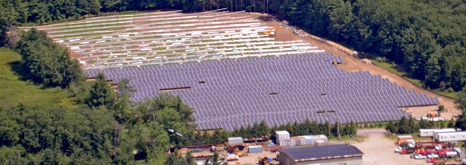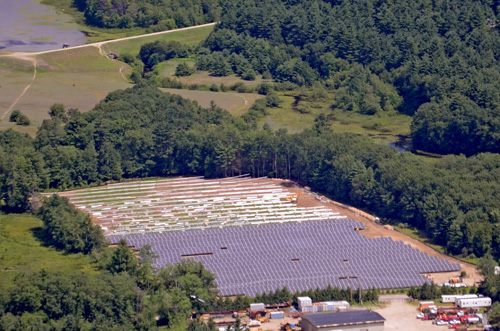

Courtesy Nancy DiGiovanni
By Nancy Arsenault
It’s in Harvard, Acton and Concord and spreading across the state – community sponsored programs that encourage residential solar installations with accompanying financial incentives.
According to Sharon Brownfield of the Stow Energy Working Group, Stow is on the cusp of a local program similar to the very successful program in nearby Concord, a town also served by a municipal electric company rather than a larger public utility.
Brownfield said that an April public forum and later a resident survey, showed that there is strong local interest in embarking upon an incentive-based solar energy program in Stow. While many residents are interested in solar for its environmentally friendly aspects, others realize the long term cost savings with solar power holds benefits, as well.
The Stow plan has been several years in the making as the group researched programs in nearby communities. State and federal authorities have also stepped up efforts as local programs have developed, offering financial incentives to homeowners, and most importantly for Stow, helping smaller, local, municipal electric companies find a way to involve their customers in the solar spectrum.
In the early stages of solar development for residential use, municipal electric companies and their customers were left behind as State monetary incentives were provided only for customers of the large public utilities. While municipal customers, like those in Stow, still cannot benefit from the financial incentives offered though the state Mass Solar program, there are now ways that Hudson Light & Power, through state approvals, can reward Stow customers who go the solar route.
Brownfield said the committee met with Hudson Light & Power and the utility was very receptive to the plan to create a “Solar Challenge” in Stow. She said that HL&P has been growing a fund that would reward homeowners with a payback of $1,000 per kilowatt hour of production installed through solar, if the installation meets certain criteria. There are also state and federal incentives, aside from the Mass Solar program, that would be available to Stow homeowners, according to Brownfield.
So how much will a solar installation cost? Gathering those numbers are at the top of the list for the Stow Energy Working Group. Brownfield said that in other communities, installers are interviewed and one is chosen as the program provider. That installer will offer tier pricing, depending on the number of homes that participate. “The more homes that sign up, the lower the cost will be for everyone,” said Brownfield.
Once the Stow committee has determined the criteria for a qualified installation company, the town will solicit pricing packages from bidders. Usually, according to Brownfield, a tiered pricing package is good for 3-4 months, leaving a concentrated window of time for customers to sign up for the program. After the pricing window expires, the installer may still contract with a homeowner, but at whatever price he may wish to negotiate.
The Solar Challenge does not just apply to residential buildings. Any type of structure can be a candidate for solar, whether municipally owned, or privately owned, residential or commercial. In Acton, the town determined that solar panels on a school could offer savings on the town utility bill, and they put the school on the list of solar installations. Gould’s Shopping Plaza on Great Road in Acton installed a roof array as part of that town’s Solar Challenge. The same type of investigations around municipal and commercially owned buildings can be expected in Stow.
In Harvard, Carlson Orchards installed a 220kw solar field alongside a parking lot, rather than on a rooftop, and now supplies 65% of the business’s power needs, including a cider production plant.
Brownfield said there are still many aspects of the potential town program that are being investigated. Concord officials have expressed an interest in possibly having Stow join their installer program, offering a greater number of customers overall, and a much lower price due to customer volume.
Brownfield also said her committee will need to do some due diligence to determine just how many parcels in Stow could successfully support a solar installation. “The town is heavily treed,” she commented, but feels there still are many clear areas that would offer ideal placements for solar arrays. “Google Maps is actually a tool that is used to look at a town and see, roughly, how many households could support solar,” she said, though it’s a laborious and not completely accurate process.
In Harvard, the Solar Challenge concluded with 75 residential customers installed. That number of customers reduced the cost of an average solar system by 25%, with a total capacity of 403 killowatts. According to Solarize Harvard, each year, these systems will reduce Harvard’s carbon footprint by 580,000 pounds. Presently, one out of every 20 households in Harvard is generating solar power.
Brownfield said there is still much work to be done before the program becomes a reality, but she encourages residents interested in learning more to contact the group through Sharon Brownfield at Sharonbrownfield@aol.com or Arnold Epstein at arnold.epstein@comcast.net. Information is also available at SustainableStow.org.